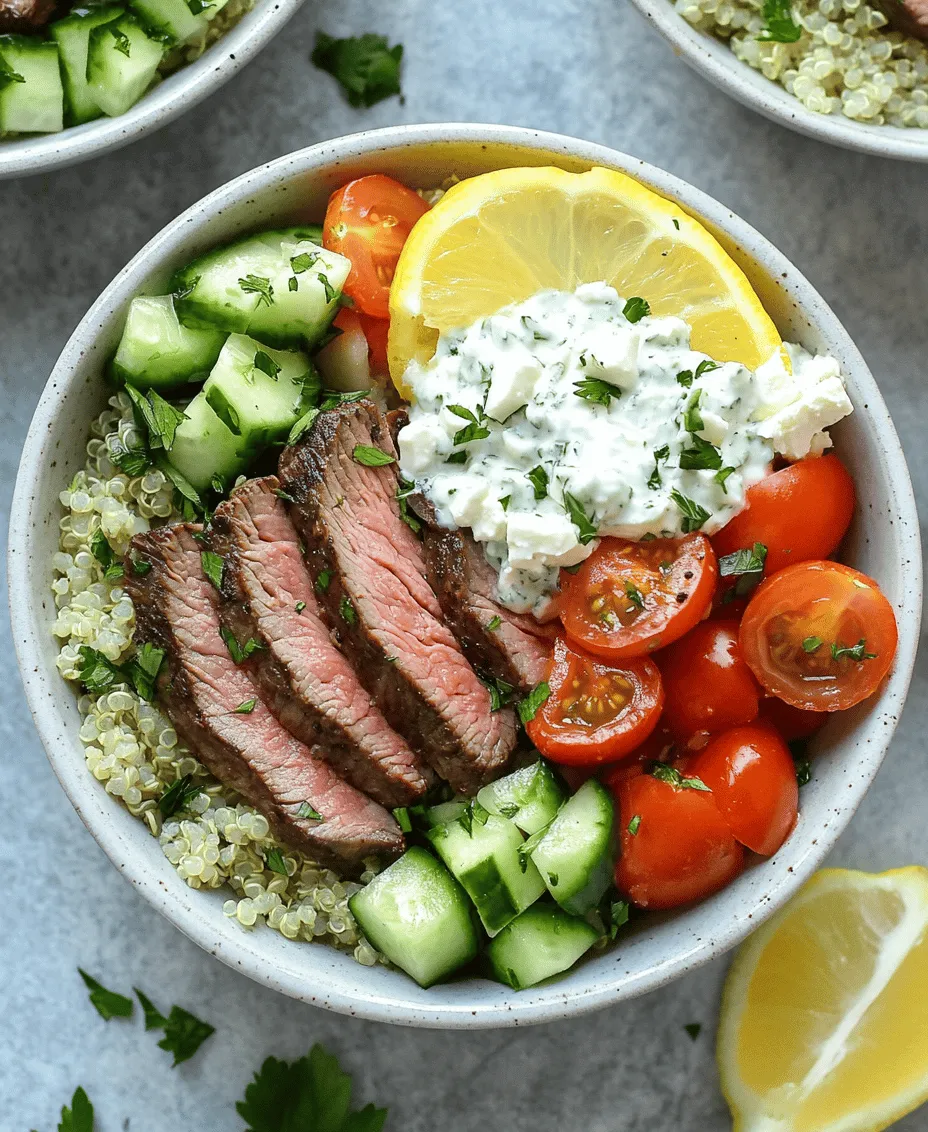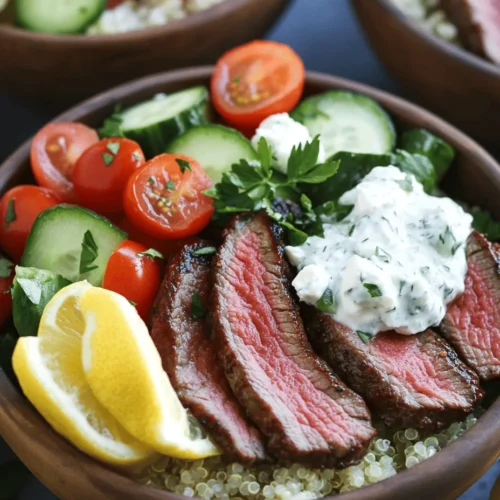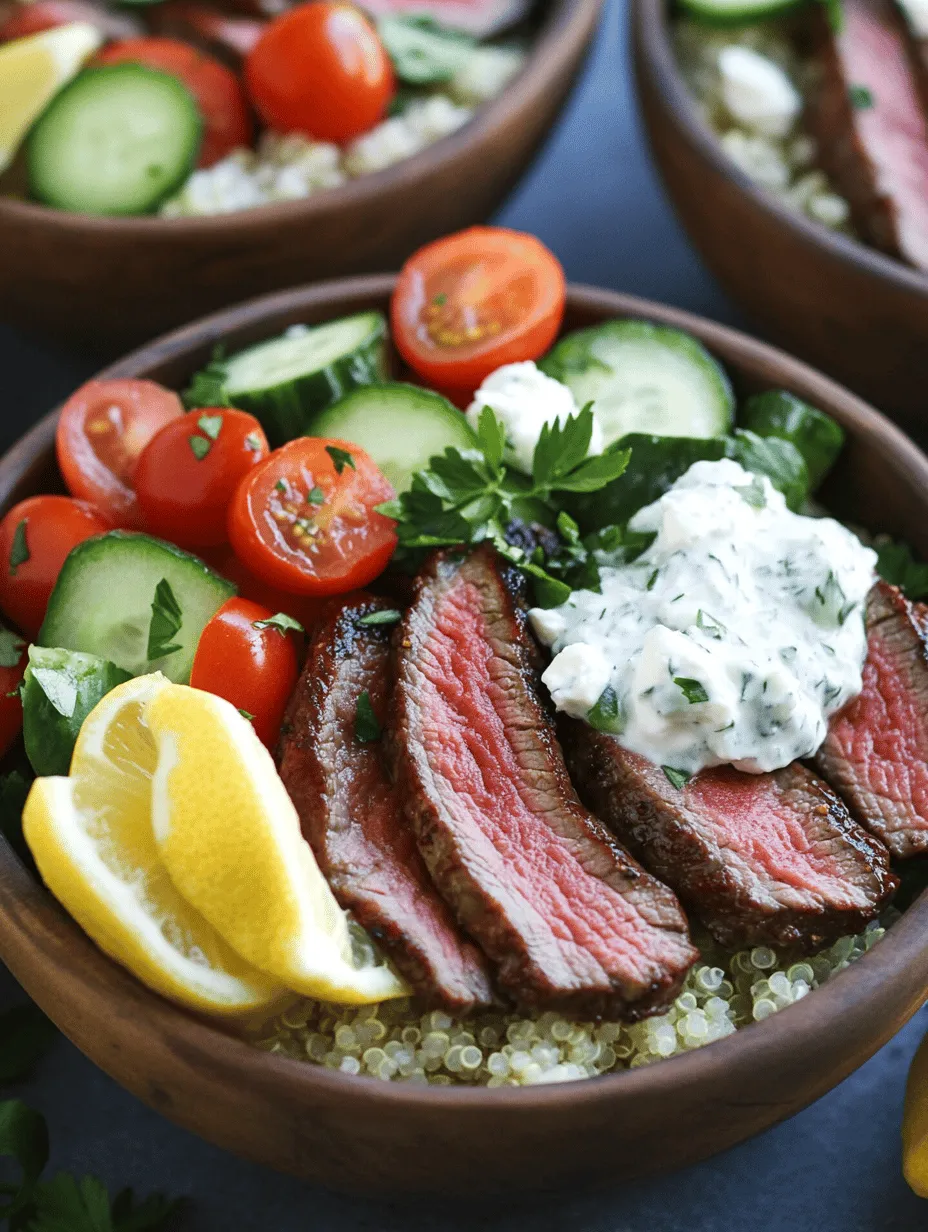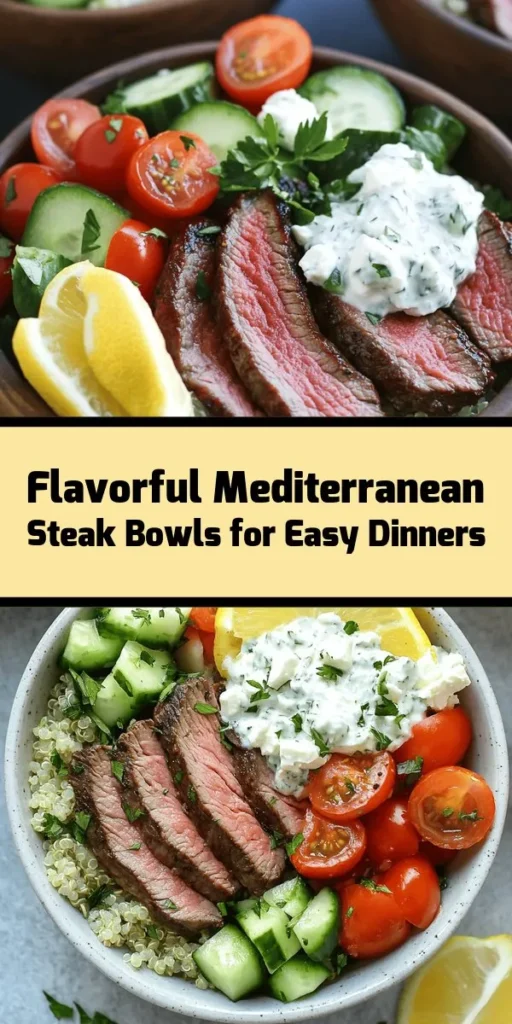Introduction
Mediterranean cuisine is celebrated not only for its vibrant flavors and colorful presentation but also for its numerous health benefits. Originating from countries bordering the Mediterranean Sea—including Greece, Italy, and Spain—this culinary tradition emphasizes fresh, wholesome ingredients, making it a delicious and nutritious choice for any meal. The Mediterranean diet is rich in fruits, vegetables, whole grains, lean proteins, and healthy fats, contributing to heart health, weight management, and overall well-being.
Among the many delightful dishes inspired by this region, Mediterranean Steak Bowls stand out as a vibrant and nutritious meal option. These bowls offer a harmonious blend of savory flank steak, fresh vegetables, and aromatic spices, all beautifully arranged to create a feast for the senses. The appeal of Mediterranean Steak Bowls lies not only in their delightful taste but also in their easy preparation and versatility. Whether you’re hosting a dinner party or looking for a quick weeknight meal, these bowls can be customized to suit any palate and dietary preference.
In this article, we will explore the key ingredients that make Mediterranean Steak Bowls a must-try dish, as well as provide step-by-step preparation instructions that will guide you in creating this flavorful meal at home.
Understanding the Ingredients
A hallmark of Mediterranean cooking is the use of fresh, high-quality ingredients that contribute to both flavor and nutrition. Each component in Mediterranean Steak Bowls plays a crucial role in creating a balanced and satisfying dish. Let’s delve into the essential ingredients that come together to make this recipe truly special.
1. Flank Steak:
Flank steak is a flavorful cut of beef that is both tender and versatile. It is known for its rich, beefy taste and works exceptionally well in marinades, which enhance its natural flavors. Nutritionally, flank steak is an excellent source of protein, iron, and essential vitamins, making it a great choice for those looking to boost their nutrient intake. The key to enjoying flank steak is in how it is prepared; when cooked properly, it can be incredibly tender and juicy.
2. Olive Oil:
A staple in Mediterranean cuisine, olive oil is revered for its heart-healthy properties. Rich in monounsaturated fats and antioxidants, it has been linked to numerous health benefits, including a reduced risk of heart disease and inflammation. Additionally, olive oil serves as a fantastic cooking medium, adding depth of flavor to the dish. When marinating the steak or drizzling over fresh vegetables, olive oil enhances the overall taste and nutritional profile of the meal.
3. Spices:
The use of spices is integral to Mediterranean cooking, and in this recipe, smoked paprika, garlic powder, and onion powder take center stage.
– Smoked Paprika: This spice adds a warm, smoky flavor that complements the grilled steak beautifully. It also contributes a rich red color, making the dish visually appealing.
– Garlic Powder: A beloved ingredient in Mediterranean recipes, garlic powder lends a robust flavor without the need for fresh garlic, allowing for easier preparation.
– Onion Powder: This spice adds a subtle sweetness and depth to the marinade, enhancing the overall flavor profile of the steak.
4. Fresh Vegetables:
Vibrant, fresh vegetables are a cornerstone of Mediterranean cuisine, providing essential vitamins, minerals, and fiber. For Mediterranean Steak Bowls, consider using ingredients such as cherry tomatoes, bell peppers, cucumbers, and red onions. These vegetables not only add color and texture to the dish but also contribute a refreshing crunch that balances the richness of the steak.
5. Quinoa vs. Rice:
The choice between quinoa and rice as a base for your Mediterranean Steak Bowls can influence both flavor and nutrition.
– Quinoa: Known as a superfood, quinoa is a complete protein, meaning it contains all nine essential amino acids. It’s also gluten-free and packed with fiber, making it a healthy alternative to traditional grains.
– Rice: If you prefer a more classic approach, rice can be used as a base. Opt for brown rice for added health benefits, as it contains more fiber and nutrients compared to white rice.
6. Kalamata Olives and Feta Cheese:
No Mediterranean-inspired dish is complete without the addition of Kalamata olives and feta cheese.
– Kalamata Olives: These dark, briny olives add a burst of flavor and richness to the bowls, enhancing the overall Mediterranean experience. They’re also a good source of healthy fats and antioxidants.
– Feta Cheese: Crumbled feta cheese adds a creamy, tangy element to the dish, providing a delightful contrast to the savory steak and fresh vegetables.
7. Tzatziki Sauce:
While optional, tzatziki sauce is a delicious and refreshing addition to Mediterranean Steak Bowls. Made from yogurt, cucumber, garlic, and herbs, this creamy sauce adds a cool, tangy flavor that complements the warm steak and spices. Tzatziki can be drizzled over the top of the bowl or served on the side for dipping.
Preparation Steps
Now that we’ve covered the essential ingredients that create the delightful Mediterranean Steak Bowls, let’s move on to the preparation steps. The process begins with marinating the steak, which is a crucial step for enhancing flavor and tenderness.
Marinating the Steak
Marinating is not just a technique for adding flavor; it also helps to tenderize the meat, making it more enjoyable to eat. For flank steak, a marinade rich in acidity and flavor is ideal. Here’s how to prepare the marinade:
1. Combine the Ingredients: In a mixing bowl, combine olive oil, smoked paprika, garlic powder, onion powder, salt, and pepper. This blend of spices and oil will infuse the steak with flavor as it marinates.
2. Marinate the Steak: Place the flank steak in a resealable plastic bag or a shallow dish and pour the marinade over it, ensuring that the meat is well-coated. Seal the bag or cover the dish and refrigerate for at least 30 minutes, although marinating for a few hours or overnight will yield even better results.
3. Importance of Marinating for Flavor Enhancement: The marinade allows the flavors to penetrate the meat, creating a more complex taste. The acidity from the olive oil and spices helps to break down the proteins in the steak, resulting in a tender and juicy final product.
Cooking the Steak
Once the steak has marinated, the next step is to cook it to perfection. Flank steak can be prepared using various methods, with grilling and skillet cooking being the most popular choices.
1. Grilling: If you have access to a grill, this method is ideal for achieving that delicious char and smoky flavor. Preheat the grill to medium-high heat and remove the steak from the marinade, allowing any excess to drip off. Place the steak on the grill and cook for about 4-5 minutes per side for medium-rare, depending on the thickness of the steak. Use a meat thermometer to ensure it reaches an internal temperature of 130-135°F for medium-rare.
2. Skillet Cooking: If grilling isn’t an option, a skillet will work just as well. Heat a tablespoon of olive oil in a cast-iron skillet over medium-high heat. Once the oil is hot, add the marinated flank steak and sear it for 4-5 minutes on each side for medium-rare. Again, use a meat thermometer to check the internal temperature.
3. Resting the Steak: After cooking, allow the steak to rest for about 5-10 minutes before slicing. This resting period helps the juices redistribute throughout the meat, resulting in a more flavorful and tender steak.
This introduction and preparation section sets the stage for creating delicious Mediterranean Steak Bowls, highlighting the vibrant ingredients and essential cooking techniques that make this recipe a standout choice for health-conscious diners and flavor enthusiasts alike. In the next part of this article, we’ll explore how to assemble these bowls, incorporating all the fresh components and optional toppings to create a visually stunning and satisfying meal.

Tips for Achieving the Perfect Doneness (Medium-Rare)
Cooking steak to the perfect medium-rare doneness is an art that can elevate your Mediterranean Steak Bowls from good to exceptional. To achieve this ideal temperature, which is about 130-135°F (54-57°C), follow these simple tips:
1. Use a Meat Thermometer: The most reliable way to ensure your steak reaches the desired doneness is to use an instant-read meat thermometer. Insert it into the thickest part of the steak, avoiding the bone and fat.
2. Know the Timing: Generally, medium-rare steak takes about 4-5 minutes per side on a hot grill or stovetop. However, thickness plays a crucial role, so always check your steak a minute or two before the expected time.
3. Look for Visual Cues: A perfectly cooked medium-rare steak will have a warm red center. The juices should run clear but still be slightly pink inside. If the juices run red, it needs more cooking time.
4. Resting is Key: After cooking, let your steak rest for about 5-10 minutes. This allows the juices to redistribute, ensuring a juicy and tender bite when sliced.
Importance of Letting the Steak Rest Before Slicing
Resting your steak is a critical step that should not be overlooked. When the steak cooks, the muscle fibers tighten and push juices toward the center. If you cut into the steak immediately after cooking, those juices will escape, resulting in a dry piece of meat. By allowing the steak to rest, the fibers relax, and the juices redistribute throughout the meat.
To rest your steak, simply place it on a cutting board and cover it loosely with aluminum foil. This will retain heat while preventing the surface from becoming overly steamed. After the resting period, slice the steak against the grain for maximum tenderness.
Vegetable Preparation
The vegetables in your Mediterranean Steak Bowls are just as important as the steak itself. Fresh, vibrant vegetables not only add flavor but also contribute significant nutritional value. Here are some tips for preparing and combining the vegetables:
1. Choose a Variety of Colors: Aim for a rainbow of vegetables such as bell peppers, cherry tomatoes, cucumbers, and red onion. This not only enhances the visual appeal but also maximizes the nutrient profile of your dish.
2. Properly Wash and Cut: Always wash your vegetables thoroughly under running water. For the best texture and flavor, cut them into bite-sized pieces—this makes them easier to eat and ensures that every bite contains a little bit of everything.
3. Seasoning for Balance: Vegetables can be seasoned simply with olive oil, salt, and pepper. You can also add a splash of lemon juice or balsamic vinegar to bring brightness and acidity, balancing the richness of the steak.
How to Properly Prepare and Combine the Vegetables
To prepare your vegetables for the Mediterranean Steak Bowls, follow these steps:
1. Roasting or Grilling: For added flavor, consider roasting or grilling some of your vegetables. Toss bell peppers, zucchini, and red onions in olive oil, salt, and pepper, and roast them at 400°F (200°C) for about 20-25 minutes until tender and slightly caramelized.
2. Fresh Toppings: Chop fresh herbs like parsley, basil, or mint to sprinkle over your bowls for a burst of freshness. These herbs are not only aromatic but also add vibrant color.
3. Layering Flavors: Combine all your chopped vegetables in a large mixing bowl. Drizzle with olive oil, sprinkle with your chosen seasonings, and toss gently. This ensures that every vegetable is coated and seasoned evenly.
Assembling the Bowls
The assembly of your Mediterranean Steak Bowls is where all the components come together to create a visually stunning and delicious meal. Follow this step-by-step guide to layer the ingredients effectively:
1. Base Layer: Start with a generous scoop of cooked quinoa or rice at the bottom of each bowl. This will serve as the base that absorbs flavors and adds texture.
2. Sliced Steak: After resting and slicing your steak against the grain, fan out the slices on top of the quinoa. This not only looks appealing but also allows the juices from the steak to seep into the base.
3. Vegetable Layer: Next, add a mix of your prepared vegetables. You can create sections within the bowl for an organized look or mix them together for a more casual presentation.
4. Finishing Touches: Top the bowls with olives, crumbled feta cheese (if desired), and a drizzle of extra virgin olive oil. You might also want to sprinkle some sumac or za’atar for an authentic Mediterranean flavor.
Ideas for Personalizing the Bowls with Additional Toppings or Variations
Feel free to customize your Mediterranean Steak Bowls according to your taste preferences or dietary needs. Here are some ideas:
– Protein Variations: Swap steak for grilled chicken, shrimp, or even chickpeas for a vegetarian option.
– Grain Alternatives: Instead of quinoa, try couscous, bulgur, or even cauliflower rice for a low-carb option.
– Additional Toppings: Add sliced avocado, roasted sweet potatoes, or a dollop of hummus for extra flavor and nutrition.
– Dressing Options: Consider drizzling a tahini-based dressing or a yogurt sauce for creaminess.
Nutritional Benefits
Mediterranean Steak Bowls are not only delicious but also packed with health benefits. Here’s a breakdown of what makes this meal a great choice:
– High Protein Content: The steak provides a substantial amount of high-quality protein, essential for muscle repair and overall health. Quinoa, a complete protein, also contributes to this aspect, making it an excellent grain choice.
– Antioxidants and Vitamins: Fresh vegetables like bell peppers and tomatoes are rich in vitamins A and C, while dark leafy greens provide iron and calcium. These antioxidants help combat oxidative stress in the body.
– Healthy Fats: The inclusion of olives and olive oil adds heart-healthy fats that are known to support cardiovascular health and promote satiety.
– Balanced Meal Profile: This meal is well-rounded, offering carbohydrates, proteins, and healthy fats, making it suitable for various dietary needs including gluten-free and paleo diets.
Serving Suggestions
To elevate your Mediterranean Steak Bowls even further, consider the following serving suggestions:
1. Complementary Side Dishes: Serve your bowls with a light Greek salad or a side of tzatziki for a refreshing contrast. Pita bread or grilled vegetables could also work well as sides.
2. Pairing Options: For beverages, consider pairing your meal with a crisp white wine like Sauvignon Blanc or a light red such as Pinot Noir. For non-alcoholic options, sparkling water with a slice of lemon or a herbal iced tea can be delightful.
3. Meal Prep and Storage: Mediterranean Steak Bowls can be prepped ahead of time. Store components separately in airtight containers in the fridge for up to 4 days. Just assemble your bowls when ready to eat to keep everything fresh.
Conclusion
Mediterranean Steak Bowls are a vibrant and nutritious option for any meal, whether it’s a weeknight dinner or a gathering with friends and family. With their rich flavors, colorful presentation, and health benefits, they are sure to impress.
Experimenting with the recipe allows you to make it your own, whether through different proteins, grains, or toppings. Cooking is about joy and creativity, so enjoy the process of creating and sharing these Mediterranean-inspired meals. Let the flavors transport you to sun-soaked shores and vibrant markets, all from the comfort of your kitchen. Happy cooking!



